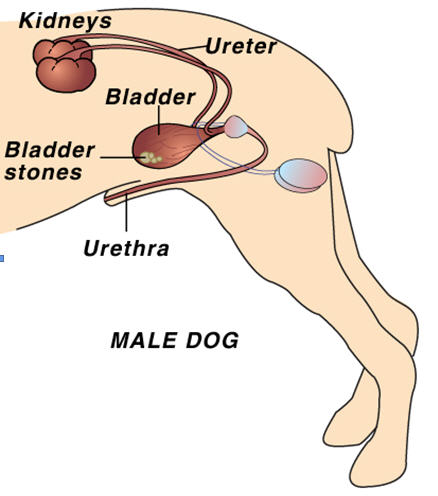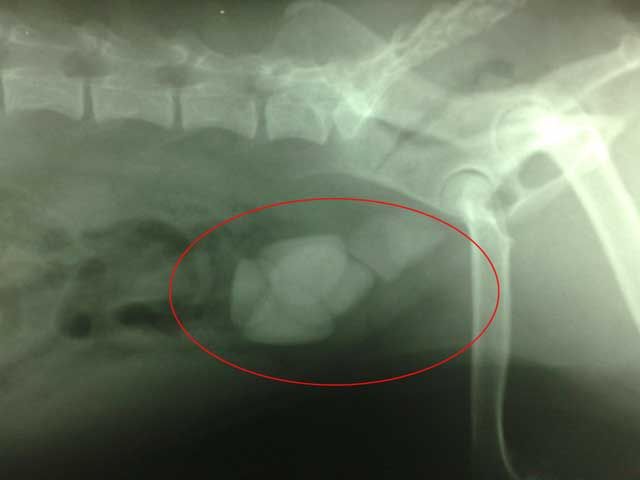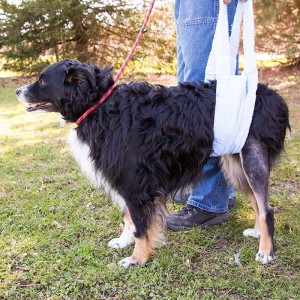Urolithiasis in dogs and cats
What is urolithiasis in dogs and cats?
Urolithiasis is the medical term for the presence of stones, also known as calculi or uroliths, in the urinary tract. These stones are most commonly found in the bladder, although they can also occur in the kidneys and the urethra (the tube through which urine passes out of the body). They can develop in quickly in just a few weeks, or more slowly over a few months. There are various types of stones, each with its own mineral composition.
In dogs and cats, the most common types of stones are:
- Struvite (composed of magnesium, ammonium and phosphate)
- Calcium oxalate
Less common are urate calculi, and rarer still are cystine and silica calculi.

Urolithiasis. Dog Bladder stone diagram. Source: https://www.vetwest.com.au/pet-library/bladder-stones-in-dogs
Cost of urinary bladder stones
Average claim cost* |
Highest claim cost* |
No of dogs affected in 2022* |
| $1,796 | $14,634 | 97 |
*Based on PetSure claims data, 2022 calendar year. Reimbursement for these claims under a pet insurance policy, would be subject to limits, such as annual benefit limits or sub-limits, benefit percentage, applicable waiting periods and any applicable excess. Cover is subject to the policy terms and conditions. You should consider the relevant Product Disclosure Statement or policy wording available from the relevant provider. Please note that values calculated are based on all claims for that condition and medically related conditions in each calendar year.
Because it is difficult to predict the costs of veterinary care, it can help to have measures in place to help prepare for the unexpected. Pet insurance can help by covering a portion of the eligible vet bill if the unexpected does happen.
Get a quote for 2 months free pet insurance for your puppy or kitten in their first year.
Symptoms of urolithiasis in dogs and cats
 Symptoms depend on the number of stones, where they are located within the urinary tract, their physical characteristics (e.g. smooth or jagged), and if there is a bacterial urinary tract infection. However, be aware that many pets with urolithiasis display no symptoms.
Symptoms depend on the number of stones, where they are located within the urinary tract, their physical characteristics (e.g. smooth or jagged), and if there is a bacterial urinary tract infection. However, be aware that many pets with urolithiasis display no symptoms.
Symptoms are commonly the result of inflammation or infection of the urinary tract, and the resultant pain and swelling. Watch out for any of the following:
- Straining, difficulty in urinating – dysuria
- Painful urination
- Frequent urination – pollakiuria
- Urinating with increased urgency
- Urinating in inappropriate locations
- Irregular flow of urine
- Blood in urine – haematuria – from stones damaging and irritating the bladder lining
- Cloudy urine
- Abnormal smell to the urine, usually if there is a bacterial infection
- Back pain or abdominal pain
- Increase in thirst
- Enlarged, swollen belly
A rare complication of urolithiasis is complete or partial obstruction of the urinary tract. This can occur if the stones pass out of the bladder with the urine and get lodged in the urethra. An obstruction is extremely dangerous as toxins will accumulate in the bloodstream and damage the kidneys, and the bladder may rupture. A complete obstruction is more common in male animals, because of the small aperture of the urethra. If you notice your pet exhibiting any of these symptoms, which could indicate an obstruction, contact the vet without delay:
- No urine flow, unable to pass urine – constantly straining
- Sudden onset of vomiting
- Anorexia
- Lethargy
- Lack of appetite
Causes of urolithiasis in dogs and cats
The formation of uroliths (bladder stones) in dogs and cats has multiple causes. Some of these are:
- Increased concentrations of certain minerals in the urine results in oversaturation of the urine, which leads to the formation of crystals. These crystals stick together and gradually form into stones, which increase in number and size over time.
- Changes to the pH (acidity or alkalinity) of the urine – different types of stones will form in acidic and alkaline urine, therefore a fairly neutral pH is desirable.
- Bacterial bladder infections can also lead to an altered pH of the urine that can result in crystal formation.
- Abnormal metabolism of certain minerals – although any breed of dog or cat can develop urolithiasis, certain breeds are predisposed to abnormal metabolism of specific minerals, for example:
- Dalmatians often don’t metabolize uric acid properly, resulting in excess uric acid in the urine, which can lead to urate uroliths.
- Newfoundlands and Siamese cats often have excess cystine in which can crystalize in the urine and lead to formation of stones (cysinuria).
- Dietary composition and mineral supplementation
- Intake of water – volume per day
- Underlying metabolic disease, e.g. overactive parathyroid glands, which leads to high blood calcium concentration
- Congenital abnormalities e.g. abnormal blood vessels
- Other unknown causes
Diagnosis of urolithiasis in dogs and cats
There are a number of procedures and diagnostic tests that your vet may use to identify urolithiasis:
- Complete medical history, including questioning about your pet’s urine
- Physical examination – a thicker bladder wall may be detected
- Palpitation of the abdomen – stones may be detected by feel through the abdominal wall
- Urinalysis – to evaluate the features of the urine
- Urine culture for presence of bacterial infection
- Abdominal ultrasound – to detect obstructions and identify their size, shape and location
- X-rays of the abdomen – denser stones may be detected
- X-rays with contrast dye, contrast urography (with air or dye) – if stones don’t appear on regular x-rays, as is common with urate uroliths
- Analysis of stones that have been passed in the urine to identify their mineral composition, for example by urinary pH and microscopic examination of a urine sample.
- Removal of small stones for analysis by means of:
- Urohydropropulsion – performed under general anaesthetic, a special catheter is used to flush out the stones, usually if the stones are very small
- Catheter-assisted urolith retrieval – performed under sedation, an instrument (cystoscope) is inserted through the urethra and into the bladder in order to remove very tiny stones
- Additional tests to exclude other conditions
Definite diagnosis can only be made when stones are extracted and analysed to determine their chemical composition.

Bladder Xray. Urolithiasis.
https://www.vetwest.com.au/pet-library/bladder-stones-in-dogs
Treatment of urolithiasis in dogs and cats
Treatment options for urolithiasis entail removal of the stones by surgical or non-surgical means. If the stones are in the urethra or tubes connecting the kidneys with the bladder, they are most likely causing obstruction and will therefore require surgical extraction.
The choice of treatment option will depend on:
- The type of stones, i.e. their mineral composition
- Location of the stone/s
- Number and size of stones
- Your pet’s general health
The main treatment options for urolithiasis
Surgery
- An operation is performed to remove the stones, usually if the stones are large and cannot be removed non-surgically, if there are too many stones, or if there is a risk of an obstruction.
- As with all surgery, there are risks involved.
- This is the most direct and efficient way to remove large stones.
- The most common surgical intervention is the a cystotomy (incision in the abdomen and bladder).
- For urethral obstructions, a urethrotomy (incision into the urethra) may be required.
- If the urethra is completely obstructed, urine backs up in the urinary tract, resulting in toxins building up in the bloodstream. This situation is life-threatening and requires immediate surgery.
- Oxalate uroliths generally require surgical removal, as they do not respond well to non-surgical treatment.
Dissolution
- Ultrasonically – High frequency ultrasound waves are used to break up the stones into very small pieces, which can come out of the bladder easier and less painfully.
- Dietary management – dissolution of certain types of stones by this method may include the following:
- Adjusting urine pH through medication and/or diet
- Antibiotics to eradicate bacterial infection
- Diluting the urine
- Attempting to reduce the mineral composition of the urine
- Following a special diet to dissolve and/or prevent stones, for example, avoiding carbs, treats and snacks, and eating certain specially formulated canned foods and a high protein diet.
- Dietary dissolution of stones is slow, taking from two weeks to five months or longer to dissolve large stones, during which time the symptoms may persist and the risk of obstruction remains.
- This method is not effective for all types of stones. It is most effective on struvite (the most common type), urate and cystine stones.
- If your animal is prone to urolithiasis, dietary management can help with prevention of certain types of stone formation, for example, calcium oxalate stones (although, ironically, these cannot be dissolved by dietary methods).
Additional treatment protocols include
- Antibiotics – if there is bacterial infection in the urinary tract
- Repetition of urine culture after antibiotics are completed to ensure that the infection has been eradicated
The risk of recurrence of urolithiasis is high; around twenty to fifty percent. If your pet responds poorly to treatment, there may be a possible underlying disease that should be investigated.
Urolithiasis is difficult to prevent. You may help by ensuring that your pet has a constant source of fresh, clean water, a high protein diet, frequent opportunities to urinate and maintains a lean body weight. Dietary management may help to prevent reoccurrence, depending on the type of stone. Prompt treatment of urinary tract infections may also help.
Overview
Just like humans, dogs and cats can develop uroliths, or mineral formations, in the urinary tract. Urolithiasis can cause irritation, infection, pain and obstruction of the flow of urine. There are different treatments for different types of stones – some can be dissolved, while others must be surgically removed. After analysing the urine or stone sample, your vet will determine the correct treatment protocol for the type of stone. Optimal treatment requires professional care from your vet, as well as special home care. It is important to carry out treatment protocols exactly as directed. Follow-up visits to the vet are essential.
If left untreated, stones can cause a blockage which could be fatal, therefore early identification is crucial. Be aware of the symptoms and monitor your pet’s urine patterns, and always contact your vet if you have any concerns. Early detection when the stones are small might make the difference between surgical and non-surgical intervention. Very importantly for both management and prevention of urolithiasis, always keep your pet well hydrated.
Bow Wow Meow Pet Insurance can help protect you and your pet should an unexpected trip to your vet occur.
- Find out more about our dog insurance options
- Find out more about our cat insurance options
- Get an instant online pet insurance quote
Bow Wow Meow is proud to have been awarded winner of Canstar’s ‘Most Satisfied Customers’ Award in the Pet Insurance category for both 2024 and 2025!
Bow Wow Meow is proud to have been chosen as Product Review’s Pet Insurance Award Winner every year from 2018 to 2025! This is based on 2,995 independent customer reviews (as at 21/01/2025), with an overall rating of 4.3*
Google Review rating = 4.5* (based on 968 reviews)
Trust Pilot rating = 4.6* (based on 531 reviews)
Bow Wow Meow is proud to have been chosen as Product Review’s Pet Insurance Award Winner every year from 2018 to 2025! This is based on 2,995 independent customer reviews (as at 21/01/2025), with an overall rating of 4.3*
Google Review rating = 4.5* (based on 968 reviews)
Trust Pilot rating = 4.6* (based on 531 reviews)
Bow Wow Meow has been chosen as a winner in the Finder Pet Insurance Awards 2024. Finder’s panel of experts analysed over 140 quotes to award our Ultimate Care Plan the winner of the “Pet Insurance – Value” category.









